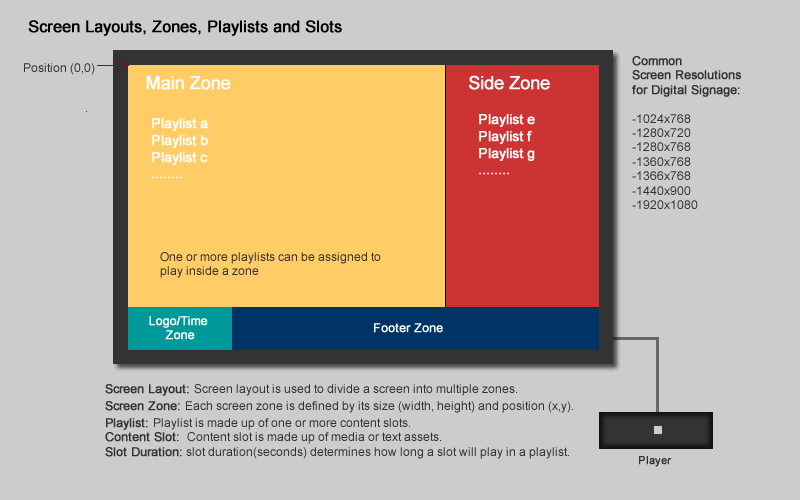
Terminology >
Player: Player is a digital signage content playback software.
A computer preinstalled with Player software is also referred as "Player System".
The output of the Player goes to your digital signage screens. Player is usually connected to a screen using a VGA cable.
Player has two functions: 1) playback content on your screens; 2) receive playlist from Publisher.
A screen can be any display panel including LCD, Plasma and projectors that are able to take a PC video output as its video input source.
Player can be connected to your local network with network cable or WiFi.
Player Activation Key: A 20-char key used to activate the Player system. Without activation, your player can only run up to 45 days.
Publisher: Publisher is a content management software application for you to manage one or many Players.
Publisher Activation Key: A 20-char key used to activate the Publisher. Without activation, your publisher can only be used up to 45 days.
Content Publishing Workstation: Publisher can be installed on a Windows XP or Windows 7 based PCs.
This PC becomes your content publishing workstation for all Players in your digital signage network.
From Publisher, you can link to the Players on the same local area network.
Application and Site: "Application" means a digital signage application.
In Publisher Professional, an application can include a group of digial signs that share the the same screen layout.
Under each application, you can have one or more sites to represent actual digital signs.
Each site can share the same content with other sites or have its own content.
You will program content at the application level.
You can choose to publish the content to all sites or any particular sites.
Screen Resolution and Orientation: Screen resolution is defined by the width and height of a screen in pixels, e.g. 1280x768 or 1360x768.
A screen can be placed with different orientations: landscape or portrait.
Screen Layout and Zone: A screen can be divided into multiple zones using Publisher's many standard built-in screen layouts or a customized screen layout.
Common screen layouts may include a main zone, a side zone, a footer zone and date/time/logo zone.
 Zone Type: there are 6 zone types based on its shape, position and usage on the screen: landscape, portrait, logo/time, footer, background, and interactive.
Zone Type: there are 6 zone types based on its shape, position and usage on the screen: landscape, portrait, logo/time, footer, background, and interactive.
 Zone Type: there are 6 zone types based on its shape, position and usage on the screen: landscape, portrait, logo/time, footer, background, and interactive.
Zone Type: there are 6 zone types based on its shape, position and usage on the screen: landscape, portrait, logo/time, footer, background, and interactive.
- Landscape: horizontal rectangular shape zone, usually for main zone on the screen.
- Portrait: vertical rectangular shape zone, usually for a side zone on a landscape screen or a main zone on a portrait screen.
- Logo/Time: a small zone for displaying logo, date and time.
- Footer: a horizontal bar shape zone for display text messages.
- Background: a zone that covers the entire screen behind all other zones.
- Interactive: a special hidden zone that support seamless interactivity feature in the Professional Edition, which allows you to seamlessly switch from a normal digital signage loop to an interactive kiosk with a single mouse click or a single touch on a touch screen display.